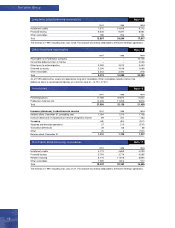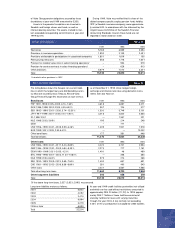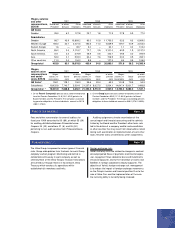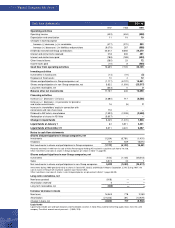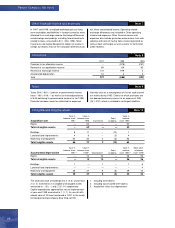Volvo 1999 Annual Report Download - page 80
Download and view the complete annual report
Please find page 80 of the 1999 Volvo annual report below. You can navigate through the pages in the report by either clicking on the pages listed below, or by using the keyword search tool below to find specific information within the annual report.
The Volvo Group
78
Credit risks in financial instruments
Credit risk in financial investments
The liquidity in the Group is invested mainly in local cash
pools or directly with Volvo Treasury. This concentrates
the credit risk within the Group’s in-house bank. Volvo
Treasury invests the liquid funds in the money and capital
markets.
All investments must meet criteria for low credit risk
and high liquidity. In accordance with Volvo’s credit policy,
counterparties for both investments and transactions in
derivatives must have received a rating of “A” or better
from one of the well-established credit-rating institutions.
Against the background of the sale of Volvo Cars the
board of AB Volvo has decided that a limited part of the
Group’s liquidity during 1999 also has been invested
with counterparties with a rating of less than A.
Counterparty risks
The derivative instruments used by Volvo to reduce its
foreign-exchange and interest-rate risk in turn give rise
to a counterparty risk, the risk that a counterparty will not
fulfill its part of a forward or options contract, and that a
potential gain will not be realized. Transactions with deri-
vative instruments are mainly conducted via Volvo
Treasury which means that the counterparty risk is con-
centrated within the Group's internal bank. Master net-
ting agreements are signed with each counterparty when
possible, to reduce the exposure. Where appropriate, the
Volvo Group arranges master netting agreements with
the counterparty to reduce exposure. The credit expos-
ure in interest-rate and foreign exchange contracts is
represented by the positive fair value – the potential gain
on these contracts – as of the reporting date. The risk
exposure is calculated daily. The credit risk in futures
contracts is limited through daily or monthly cash settle-
ments of the net change in value of open contracts. The
estimated exposure in currency interest-rate swaps, for-
ward exchange contracts and futures and options pur-
chased amounted to 3,055, 4,143 and 67 as of
December 31, 1999.
Volvo does not have any significant exposure to an
individual customer or counterparty.
Calculation of fair value of financial instruments
Volvo has used generally accepted methods to calculate
the market value of the Group’s financial instruments as
of December 31, 1997, 1998 and 1999. In the case of
instruments with maturities shorter than three months –
such as liquid funds and certain current liabilities as well
as certain short-term loans – the book value has been
assumed to closely approximate market value.
Official exchange rates and prices quoted in the open
market have been used initially for purposes of valuation.
In their absence, the valuation has been made by dis-
counting future cash flows at the market interest rate for
each maturity. These values are estimates and will not
necessarily be realized.
Estimated fair value of Volvo’s financial instruments
December 31, 1997 December 31, 1998 December 31, 1999
Book Fair Book Fair Book Fair
value value value value value value
Balance sheet items
Investments in shares and participations
fair value determinable12,089 5,779 1,110 851 3,537 2,212
fair value not determinable 2361 — 132 – 241 –
Long-term receivables and loans 19,690 19,682 31,349 31,362 36,240 36,751
Short-term receivables and loans 20,459 20,477 23,674 23,641 17,508 17,288
Marketable securities 10,962 11,203 7,168 7,562 20,956 21,534
Long-term loans and debts 23,135 24,168 26,012 26,882 32,514 32,394
Short-term loans 18,282 18,309 38,876 39,025 21,123 20,429
Off-balance-sheet items
Volvo Group outstanding currency contracts (199) 3(1,716) (673) 3(896) 16 (1,946)
Volvo Group outstanding interests related contracts (77) 3(957) (334) 3(266) (15) 8
Volvo Group outstanding raw material contracts – – – (77) – –
1 Pertains mainly to Volvo’s holdings in Pharmacia & Upjohn,
Inc 1997, and in Mitsubishi Motors Corporation 1999.
2 No single investment represents any significant amount.
3 Book values are included among items in the
balance sheet.


